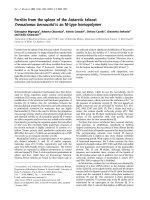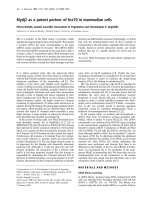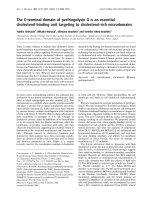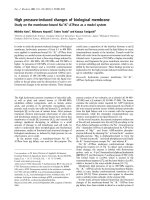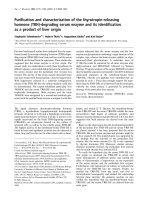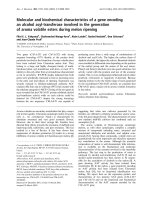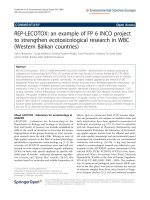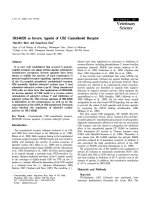Báo cáo y học: "Ragweed as an Example of Worldwide Allergen Expansion" doc
Bạn đang xem bản rút gọn của tài liệu. Xem và tải ngay bản đầy đủ của tài liệu tại đây (137.82 KB, 6 trang )
ORIGINAL ARTICLE
Ragweed as an Example of Worldwide Allergen Expansion
Matthew L. Oswalt, MD and Gailen D. Marshall Jr, MD, PhD, FACP
Multiple factors are contributing to the expansion of ragweed on a worldwide scale. This review seeks to examine factors that may
contribute to allergen expansion with reference to ragweed as a well-studied example. It is our hope that increased surveillance for
new pollens in areas not previously affected and awareness of the influence the changing environment plays in allergic disease will
lead to better outcomes in susceptible patients.
Key words: allergens, allergen expansion, CO
2
, global warming, ozone, ragweed
M
ultiple factors are contributing to the expansion of
allergens on a worldwide scale. Increased travel and
trade have led to the introduction of certain allergenic
species to other environments that had never seen them
previously.
1
These include pollens from many plant species
that are new to these environments. The climate changes
that are occurring owing to global warming may serve as
another influence that will allow new allergens to expand
into different regions in the future. These changes include
the increasing length of the growing seasons, changes in
agricultural practices, ozone exposure, and increased
atmospheric CO
2
levels. Exposure to air pollutants has
been repeatedly shown to influence the immune system’s
response to allergens.
2,3
Long-distance transport of
anemophilus pollens could represent a source of pollen
exposure for inhabitants in areas in which the species are
not present in sufficient quantities to invoke symp-
toms.
1,4,5
As allergy sufferers are exposed to increasing
amounts of air pollution in the future, this could lead to
increased sensitization and thus symptoms. Increased
allergen exposure may have a number of detrimental
effects on the exposed population related to higher rates of
sensitization. Sensitization in children can lead to the
classic ‘‘allergic march,’’ which includes a progression from
atopic dermatitis and/or allergic rhinitis to asthma.
6
In
adults, new allergen sensitization may increase the
development of allergic disease, with persistence of
symptoms into older adulthood or asymptomatic sensiti-
zation that does not develop clinically until later in life.
7
This notion is supported by the change in prevalence for
allergic rhinitis in the US population from 10% in 1970 to
30% in 2000.
8
In addition to asthma and rhinitis,
allergic sensitization also increases the rates of rhinosinu-
sitis.
9
The prevalence of drug allergy, food allergy, and
anaphylaxis may also be increased since atopic sensitiza-
tion is a risk factor for all of these maladies.
8
Only with
specific knowledge of the etiology and implications of
these changes can researchers and physicians maximally
assist allergic patients. The purpose of this review is to
examine factors that may contribute to allergen expansion,
with specific reference to ragweed as a well-studied
example.
Ragweed as an Example of Allergen Expansion
Ragweed serves as a novel allergenic species that has
expanded on a global scale. Recent studies of this pollen
and its allergenic potentials serve to illustrate the possible
future impact of major climate changes.
Plants of the genus Ambrosia (ragweed) belong to the
Asteraceae family. There are 22 known allergens, with 6
considered major.
10
In North America, 17 species of
ragweed have been discovered.
11
The only native species in
Europe is Ambrosia maritima L., but four other species,
Ambrosia artemisiifolia L. (short or common ragweed),
Ambrosia coronopifolia, Ambrosia tenuifolia, and Ambrosia
trifida L., have all been introduced from other locations.
12
Ambrosia artemisiifolia is one of the most common causes
of respiratory allergy in North America. The pollen is
Matthew L. Oswalt and Gailen D. Marshall Jr: Division of Clinical
Immunology and Allergy, Department of Medicine, The University of
Mississippi Medical Center, Jackson, MS.
Correspondence to: Gailen D. Marshall Jr, MD, PhD, FACP, Division of
Clinical Immunology and Allergy, Department of Medicine, The
University of Mississippi Medical Center, 768 Lakeland Drive, Building
LJ, Jackson, MS 39216; e-mail:
DOI 10.2310/7480.2008.00016
130 Allergy, Asthma, and Clinical Immunology, Vol 4, No 3 (Fall), 2008: pp 130–135
tricolporate, with a spiny, granular surface.
13
It tends to
grow in large numbers, and a single plant can release about
1 billion pollen grains in a season.
14
The plants grow to
about 1.2 metres in height and have pollen grains that are
about 15 to 25 mm in size.
15
Although most larger pollen
grains cannot deposit deep in the peripheral airways, it has
been demonstrated that ragweed pollen exists in particle
sizes of less than 10 mm
16–18
that could potentially lead to
lower respiratory symptoms. It was recently reported that
subpollen particles released from ragweed pollen grains,
ranging in size from 0.5 to 4.5 mm, could induce allergic
inflammation in an animal model.
19
It has been estimated that symptoms after exposure to
ragweed pollen can begin with concentrations of as few as
5 to 20 pollen grains/m
3
.
20,21
In the midwestern United
States, the typical pollen count during ragweed season is
about 200 grains/m
3
.
22
Ragweed tends to grow in fields and in freshly cleared
grounds. It is considered an annual disturbance weed that
completes its life cycle in 1 year and requires the clearing
or disturbance of the soil for future growth.
14
The
expansion of ragweed in both the United States and
Europe has been attributed to increasing deforestation and
economic development.
12
Ragweed in North America
It is believed that ragweed originated in South America
and flourished in the United States when more grounds
were disturbed during expansion. Ragweed also was a
significant problem in the slums and vacant lots in heavily
industrialized cities.
23
Early twentieth century efforts to
‘‘eradicate’’ ragweed from several regions in the United
States were unsuccessful, and now ragweed represents one
of the major national allergens.
In the recent National Health and Nutrition
Examination Survey (NHANES) III (1988–1994), 26.2%
of the US population was sensitized to ragweed, the third
most common allergen after dust mites (27.5%) and
perennial rye grass (26.9%).
24
This prevalence was
increased from 10% of the population in NHANES II
(1976–1980).
25
Ragweed is also a major allergen in
Canada. In a series of 3,371 atopic patients, Boulet and
colleagues discovered that 44.9% were sensitized to
ragweed.
26
Expansion of Ragweed Worldwide
The expansion of ragweed species into European countries
has been well chronicled. The Carpathian Basin in
Hungary is an area that reports some of the highest
ragweed pollen concentrations in Europe, with counts that
were 77 to 87% of the total pollen count during the 1
month of highest release from 1997 to 2001.
27
Ragweed is thought to have been introduced into
France with potato sacks, American war supplies, and
cereal sacks in the 1930s to 1960s.
10
The Rhone-Alps
and Burgandy regions are considered to be the areas in
France that have been affected the most.
28
Laaidi and
colleagues investigated pollen counts in the city of Lyon
between 1987 and 2001.
10
Data revealed a rising trend,
with 143 to 403 grains/m
3
maximum between 1994 and
2001, increased from 19 to 126 grains/m
3
during 1987 to
1993.
Ragweed is also an increasing problem in Italy.
29
Asero
reported a trend toward ragweed sensitization at a younger
age in areas of northern Italy over the last few years.
30
This
is in contrast to his earlier finding that most ragweed-
sensitized individuals in the area were over 35 years old,
31
stressing the point that the evolving expansion of ragweed
is greatly affecting patients in the area.
Ragweed pollen counts at three sites in central Croatia
during 2002 to 2003 were greater than 30 grains/m
3
for 19
to 45 days in 2002 and 30 to 54 days in 2003. This
represented the third most abundant pollen type in that
study.
32
In northeastern Croatia, ragweed pollen was
present in concentrations greater than 10 grains/m
3
for
51, 44, and 35 days during the 2001–2003 seasons. The
maximum daily concentration in this study was 528
grains/m
3
.
33
In southern Croatia, 47% of 120 patients who
had symptoms and positive skin tests during the ragweed
season reacted to Ambrosia in 2003. Ragweed pollen
represented a maximum of 12% of the total weekly pollen
count during the peak season.
34
Analysis of pollen counts in the Czech Republic
between 1992 and 1997 revealed significant levels of pollen
only occasionally from the station in Brno.
35
Incidentally,
in the same study, a skin-prick test or specific IgE by
radioallergosorbent test in a group of over 200 adults each
year between 1995 and 1997 in Brno revealed 19 to 25% to
be sensitized to ragweed.
In Switzerland, there has been an increasing trend in
measured ragweed pollen counts in Geneva since sampling
was started in 1979. Although the number of ragweed-
sensitized patients in the Geneva area is low, there are cases
that have been related to local sensitization.
12
It is thought
that imported contaminated birdseed is a major source of
ragweed introduction into Sweden.
1
Ragweed has also
been noted in Austria,
36
Bulgaria,
37
Poland,
38
and
Slovakia.
39
Oswalt and Marshall, Ragweed as an Example of Worldwide Allergen Expansion 131
Environmental Factors
Long-Distance Transport
Owing to the small size of the ragweed pollen grain, the
ability of the pollen to travel long distances has been
studied by a number of researchers. Although ragweed
species are not present in the areas of central Italy, Cecchi
and colleagues reported increased collection over the
period from 1999 to 2004 in the areas of Florence and
Pistoia.
4
Between August 20 and September 20 over the
last 3 years of the study, the levels were above 10 grains/m
3
for 80 to 90% of the time.
4
A study by Stach and colleagues
calculated the amount of Ambrosia pollen in the Poznan
area of Poland between 1995 and 2005.
5
It was shown by
back-trajectory analysis that it was possible that long-range
transport from southern Poland, Slovakia, Hungary, and
the Czech Republic could be attributed to the observed
ragweed pollen counts. There were 18 days during the
study in which the counts were greater than 20 grains/m
3
.
Other studies have also noted that long-range transport of
ragweed pollen can occur.
1,40
Effects of Agriculture
Local agricultural practices can influence the types of
plants that are able to survive and proliferate in an area.
The expansion of ragweed has been attributed to changes
in agricultural practice. In their study of ragweed in
France, Laaidi and colleagues postulated that the European
Common Agricultural Policy that required farmers to
leave part of their land lying fallow increased this potential
source of ragweed growth.
10
They also suggested that an
increase in sunflower crops in the area could have
increased proliferation of ragweed because they both
belong to the Asteraceae family and grow well together
and because herbicides cannot be used on ragweed owing
to fear of destroying the sunflower crops.
Effects of Higher CO
2
Levels
It has been predicted that atmospheric CO
2
levels will
increase in the future as a result of global climate
change.
41,42
A few studies have attempted to explore the
impact of this predicted change on the growth and pollen
production of ragweed. Ziska and Caulfield found that
higher CO
2
concentrations yielded elevated levels of pollen
production and biomass from ragweed.
43
Wayne and
colleagues also noted that ragweed pollen production was
61% higher in plants grown in elevated CO
2
environments,
a finding that might suggest that ragweed pollen produc-
tion could increase as global warming progresses.
44
In an
experiment using the differences between urban and rural
environments as a surrogate for possible future climate
changes, Ziska and colleagues found that greater ragweed
biomass and atmospheric pollen counts were encountered
in the urban area. The urban area had 30 to 31% higher
average daily CO
2
concentrations and a 1.9uC temperature
increase relative to the rural site.
45
They also noted that
ragweed flowered earlier in urban compared with rural
sites.
Length of Seasons
It has been postulated that the changing environment,
particularly the trend of global warming, may lead to
increased pollen exposure and expanded environments for
growth of numerous plant species.
21
An increase in the
growing season with earlier flowering and possible
increased airborne pollen counts could be consequences
of the projected rise in temperature. A number of studies
addressing plant and animal phenophases (recurrence of
annual phenomena such as plant budding) have been
performed. Polar areas or areas of colder climates seem to
be particularly susceptible to warming, as evidenced by
studies of plant phenophases in these areas.
46
In a
phenologic survey in southern Wisconsin with events
recorded over a 61-year period, it was determined that the
mean of regressions for the 55 phenophases studied was
20.12 days per year.
47
In a review of phonologic events in
Europe with data from the International Phenological
Gardens over a 30-year period, Menzel noted a lengthen-
ing of the growing season by +0.36 day/year (an
advancement of spring by 6.3 days and a delay in fall of
4.3 days).
48
It was also noted in this study that the
advancement was more pronounced in areas of northern
and central Europe. With respect to the ragweed plant, this
trend might be relevant to areas in which the current
vegetation period is too short to allow full seed maturity,
such as Sweden.
1
In a comparison of ragweed plants released from
dormancy at three 15-day intervals, Rogers and colleagues
determined that the plants released from dormancy first
had increased height, increased weight, and 54.8% greater
production of pollen compared with plants released at the
last interval.
49
These data suggest that ragweed pollen
production might increase with the earlier onset of spring
and longer growing season that will accompany climactic
changes in the future.
Other pollens have also been studied in relation to the
lengthening of the growing season. Emberlin and collea-
132 Allergy, Asthma, and Clinical Immunology, Volume 4, Number 3, 2008
gues looked at birch pollen start dates and temperatures
from six European cities over the 1982–1999 time period
and used regression analysis to predict future trends.
50
It
was noted that most of the sites showed earlier start dates,
with a postulated 6-day increase in pollen start dates over
the next 10 years if trends continue. Data from Switzerland
indicate that birch pollen appears 3 weeks and ash pollen 1
week earlier than 20 years previously.
51
Researchers using a
climate change model based on predicted meteorologic
changes and past Quercus pollen data in the Iberian
Peninsula area of Spain postulated that the pollination
season could begin as much as 1 month earlier, with as
much as a 50% greater airborne pollen concentration by
the end of the twenty-first century.
52
Environmental Interactions
Although the expansion of allergens worldwide has led to
increased numbers of individuals who have been sensi-
tized, the exposure of these individuals to environmental
changes and air pollution might also lead to increased
disease activity. One such example is the exposure of
allergic patients to increasing amounts of ozone. In a study
of mild asthmatics with sensitivity to Dermatophagoides
farinae by Peden and colleagues, exposure to ozone levels
of 0.16 ppm for 7.6 hours yielded a significant increase in
both eosinophils and neutrophils in bronchoalveolar
lavage fluid sampled at 18 hours after exposure.
53
Ozone exposure also resulted in a significant decrease in
both forced vital capacity and forced expiratory volume
in 1 second in this group of patients. The effect of
exposure to diesel exhaust particles (DEPs) in allergic
patients has also been studied by a number of re-
searchers. Dust mite–sensitive patients who were chal-
lenged with 0.3 mg of DEPs prior to allergen exposure
yielded a dramatic increase in nasal symptom scores that
correlated with histamine levels in nasal lavage fluid.
2
In
another study in ragweed-sensitive rhinitis patients, the
combination of ragweed and DEP exposure yielded a
statistically significant increase in the amount of ragweed-
specific IgE in nasal lavage compared with ragweed
exposure alone.
3
Conclusion
Ragweed serves as an ideal example for discussing the
spread of allergens on an international scale and illustrat-
ing the effects of the changing environment on allergic
disease. With the prevalence of allergic diseases increas-
ing,
54
it becomes important to study these confounding
factors that increase sensitization and/or symptoms so that
effective interventions can be designed and implemented.
The observations that the growing seasons appear to
be increasing in length could have dramatic implications
for expansion of allergenic plants into regions with
colder climates and the level of pollens in areas where
the species already exists in adequate numbers. Studies
with ragweed have also shown that airborne spread to
regions in which the species is not prevalent could lead to a
significant number of days with sufficient levels of
exposure to produce allergic symptoms.
4,5
Exposure to
ozone and air pollution has also been shown to influence
allergic disease. Given that DEPs are significant compo-
nents of the air in most industrialized countries,
3
the
recent studies linking DEPs to increased indices of allergic
disease are very concerning. It is hoped that increased
surveillance for new pollens in areas not previously
affected and awareness of the environmental influence on
patients with allergic disease will lead to better prevention
of allergic sensitization and control of symptoms in
susceptible patients.
References
1. Dahl A, Strandhede A, Wihl J. Ragweed—an allergy risk in
Sweden? Aerobiologia 1999;15:293–7.
2. Diaz-Sanchez D, Penichet-Garcia M, Saxon A. Diesel exhaust
particles directly induce activated mast cells to degranulate and
increase histamine levels and symptom severity. J Allergy Clin
Immunol 2000;106:1140–6.
3. Fujieda S, Diaz-Sanchez D, Saxon A. Combined nasal challenge
with diesel exhaust particles and allergen induces in vivo IgE
isotype switching. Am J Respir Cell Mol Biol 1998;19:507–12.
4. Cecchi L, Morabito M, Paola Domeneghetti M, et al. Long distance
transport of ragweed pollen as a potential cause of allergy in central
Italy. Ann Allergy Asthma Immunol 2006;96:86–91.
5. Stach A, Smith M, Skjoth CA, Brandt J. Examining Ambrosia
pollen episodes at Poznan (Poland) using back-trajectory analysis.
Int J Biometeorol 2007;51:275–86.
6. Wahn U. What drives the allergic march? Allergy 2000;55:591–9.
7. Nelson HS. The importance of allergens in the development of
asthma and the persistence of symptoms. Dis Mon 2001;47:
5–15.
8. Bosquet J, Khaltaev N, Cruz AA, et al. Allergic rhinitis and its
impact on asthma (ARIA) 2008 update (in collaboration with the
World Health Organization, GA(2)LEN and AllerGen). Allergy
2008;62 Suppl 86:8–160.
9. Ahmad N, Zacharek MA. Allergic rhinitis and rhinosinusitis.
Otolaryngol Clin North Am 2008;41:267–81.
10. Laaidi M, Laaidi K, Besancenot J, Thibaudon M. Ragweed in
France: an invasive plant and its allergenic pollen. Ann Allergy
Asthma Immunol 2003;91:195–201.
11. Jelks M. Allergy plants. 1st ed. Tampa (FL): World-Wide Printing;
1987.
Oswalt and Marshall, Ragweed as an Example of Worldwide Allergen Expansion 133
12. Taramarcaz P, Lambelet C, Clot B, et al. Ragweed (Ambrosia)
progression and its health risks: will Switzerland resist this
invasion? Swiss Med Wkly 2005;135:538–48.
13. Mohapatra SS, Lockey RF, Polo F. Weed pollen allergens. In:
Lockey RF, Bukantz SC, Bousquet J, editors. Allergens and allergen
immunotherapy. 3rd ed. London: Marcel Decker; 2004. p. 207–22.
14. Thompson JL, Thompson JE. The urban jungle and allergy.
Immunol Allergy Clin North Am 2003;23:371–87.
15. Esch RE, Bush RK. Aerobiology of outdoor allergens. In:
Adkinson NF Jr, Yunginger JW, Busse WW, et al, editors.
Middleton’s allergy: principles and practice. 6th ed. Philadelphia:
Mosby; 2003. p. 529–55.
16. Agarwal MK, Swanson MC, Reed CE, Yunginger JW. Airborne
ragweed allergens: association with various particle sizes and short
ragweed plant parts. J Allergy Clin Immunol 1984;74:687–93.
17. Soloman WR, Burge HA, Muilenberg ML. Allergen carriage by
atmospheric aerosol. I. Ragweed pollen determinants in smaller
micronic fragments. J Allergy Clin Immunol 1983;72(5 Pt 1):443–
7.
18. Habenicht HA, Burge HA, Muilenberg ML, Soloman WR. Allergen
carriage by atmospheric aerosol. II. Ragweed-pollen determinants
in submicronic atmospheric fractions. J Allergy Clin Immunol
1984;74:64–7.
19. Bacsi A, Choudhury BK, Dharajiya N, et al. Subpollen particles:
carriers of allergenic proteins and oxidases. J Allergy Clin Immunol
2006;118:844–50.
20. Banken R, Comtois P. Concentration of ragweed pollen and
prevalence of allergic rhinitis in 2 municipalities in the Laurentides.
Allerg Immunol (Paris) 1992;24:91–4.
21. Emberlin J. The effects of patterns in climate and pollen abundance
on allergy. Allergy 1994;49:15–20.
22. Portnoy J, Barnes C. Clinical relevance of spore and pollen counts.
Immunol Allergy Clin North Am 2003;23:389–410.
23. Mitman G. Breathing space. 1st ed. New Haven (CT): Yale
University Press; 2007.
24. Arbes SJ Jr, Gergen PJ, Elliott L, Zeldin DC. Prevalences of positive
skin test responses to 10 common allergens in the US population:
results from the third National Health and Nutrition Examination
Survey. J Allergy Clin Immunol 2005;116:377–83.
25. Gergen PJ, Turkeltaub PC, Kovar MG. The prevalence of allergic
skin test reactivity to eight common aeroallergens in the U.S.
population: results from the second National Health and Nutrition
Examination Survey. J Allergy Clin Immunol 1987;80:669–79.
26. Boulet LP, Turcotte H, Laprise C, et al. Comparative degree and
type of sensitization to common indoor and outdoor allergens in
subjects with allergic rhinitis and/or asthma. Clin Exp Allergy 1997;
27:52–9.
27. Makra L, Juhasz M, Borsos E, Beczi R. Meteorological variables
connected with airborne ragweed pollen in southern Hungary. Int
J Biometeorol 2004;49:37–47.
28. Laaidi K, Laaidi M. Airborne pollen of Ambrosia in Burgandy
(France) 1996–1997. Aerobiologia 1999;15:65–9.
29. Mandrioli P, Di Cecco M, Andina G. Ragweed pollen: the
aeroallergen is spreading in Italy. Aerobiologia 1998;14:13–20.
30. Asero R. The changing pattern of ragweed allergy in the area of
Milan, Italy. Allergy 2007;62:1097–9.
31. Asero R. Birch and ragweed pollinosis north of Milan: a model to
investigate the effects of exposure to ‘‘new’’ airborne allergens.
Allergy 2002;57:1063–6.
32. Peternel R, Culig J, Srnec L, et al. Variation in ragweed (Ambrosia
artemisiifolia L.) pollen concentration in central Croatia, 2002-
2003. Ann Agric Environ Med 2005;12:11–6.
33. Stefanic E, Kovacevic V, Lazanin Z. Airborne ragweed pollen
concentration in north-eastern Croatia and its relationship
with meteorological parameters. Ann Agric Environ Med 2005;
12:75–9.
34. Cvitanovic S, Znaor L, Kanceljak-Macan B, et al. Allergic rhinitis
and asthma in southern Croatia: impact of sensitization to
Ambrosia elatior. Croat Med J 2007;48:68–75.
35. Rybnicek O, Novotna B, Rybnickova E, Rybnicek K. Ragweed in
the Czech Republic. Aerobiologia 2000;16:287–90.
36. Ja
¨
ger S. Ragweed (Ambrosia) sensitization rates correlate with the
amount of inhaled airborne pollen. A 14-year study in Vienna,
Austria. Aerobiologia 2000;16:149–53.
37. Yankova R, Zlatev V, Baltadjieva D, et al. Quantitative dynamics
of Ambrosia pollen grains in Bulgaria. Aerobiologia 2000;16:
299–301.
38. Piotrowska K, Weryszko-Chmielewska E. Ambrosia pollen in the
air of Lublin, Poland. Aerobiologia 2006;22:151–8.
39. Bartkova
´
-s
ˇ
c
ˇ
evkova
´
J. The influence of temperature, relative
humidity and rainfall on the occurrence of pollen allergens
(Betula, Poaceae, Ambrosia artemisiifolia) in the atmosphere of
Bratislava (Slovakia). Int J Biometeorol 2003;48:1–5.
40. Belmonte J, Vendrell M, Roure JM, et al. Levels of Ambrosia pollen
in the atmospheric spectra of Catalan aerobiological stations.
Aerobiologia 2000;16:93–9.
41. Prentice IC, Farquhar GD, Fasham MJR, et al. The carbon cycle
and atmospheric carbon dioxide. In: Houghton JT, Ding Y,
Griggs DJ, et al, editors. Climate change 2001: the scientific basis,
contribution of Working Group I to the Third Assessment Report
of the Intergovernmental Panel on Climate Change. Cambridge:
Cambridge University Press; 2001. p. 183–237.
42. Beggs PJ. Impacts of climate change on aeroallergens: past and
future. Clin Exp Allergy 2004;34:1507–13.
43. Ziska K, Caulfield F. The potential influence of rising atmo-
spheric carbon dioxide (CO
2
) on public health: pollen production
of the common ragweed as a test case. World Res Rev 2000;12:449–
57.
44. Wayne P, Foster S, Connolly J, et al. Production of allergenic
pollen by ragweed (Ambrosia artemisiifolia L.) is increased in
CO2-enriched atmospheres. Ann All Asthma Immunol 2002;88:
279–82.
45. Ziska LH, Gebhard DE, Frenz DA, et al. Cities as harbingers of
climate change: common ragweed, urbanization, and public health.
J Allergy Clin Immunol 2003;111:290–5.
46. Chapin III FS, Shaver GR, Giblin A, et al. Responses of Arctic
tundra to experimental and observed changes in climate. Ecology
1995;76:694–711.
47. Bradley NL, Leopold AC, Ross J, Huffaker W. Phenological
changes reflect climate change in Wisconsin. Proc Natl Acad Sci U
S A 1999;96:9701–4.
48. Menzel A. Trends in phonological phases in Europe between 1951
and 1996. Int J Biometeorol 2000;44:76–81.
49. Rogers CA, Wayne PM, Macklin EA, et al. Interaction of the onset
of spring and elevated atmospheric CO
2
on ragweed (Ambrosia
artemisiifolia L.) pollen production. Environ Health Perspect 2006;
114:865–9.
134 Allergy, Asthma, and Clinical Immunology, Volume 4, Number 3, 2008
50. Emberlin J, Detandt M, Gehrig R, et al. Responses in the start of
Betula (birch) pollen seasons to recent changes in spring
temperatures across Europe. Int J Biometeorol 2002;46:159–70.
51. Schneiter D, Bernard B, Defila C, Gehrig R. Effect of climate
changes on the phenology of plants and the presence of pollen in
the air of Switzerland. Allerg Immunol (Paris) 2002;34:113–6.
52. Garcia-Mozo H, Galan C, Jato V, et al. Quercus pollen season
dynamics in the Iberian Peninsula: response to meteorological
parameters and possible consequences of climate change. Ann
Agric Environ Med 2006;13:209–24.
53. Peden DB, Boehlecke B, Horstman D, Devlin R. Prolonged acute
exposure to 0.16 ppm ozone induces eosinophilic airway
inflammation in asthmatic subjects with allergies. J Allergy Clin
Immunol 1997;100:802–8.
54. Beasley R, Crane J, Lai CKW, Pearce N. Prevalence and etiology of
asthma. J Allergy Clin Immunol 2000;105:S466–72.
Oswalt and Marshall, Ragweed as an Example of Worldwide Allergen Expansion 135

